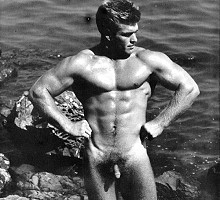by Carlson Wade
Part I
Few civilizations have ever attained the glory that was Greece; few, if any, societies have ever achieved such a healthful attitude toward nakedness and the health-giving benefits of nudity as the Greeks. The famed Greek Olympics were an expression of the delight of the people in the human body. It is extremely difficult for modern folks, accustomed to the wearing of clothes, to understand the motives of the Greeks for nudity at their games.
A sense of shame was occasioned by the wearing of clothes not the reverse and garments were worn for climatic and hygienic reasons. The Greeks felt that to cover the private parts alone, when the rest of the body was unencumbered with clothing, would suggest some contempt or feeling of shame for the genitals, where in fact their opinion on the subject was the exact opposite: the genitalia, as the instrument of exalted pleasure and miraculous fertility, inspiring them with gratitude and awe.
 Nude Greek Boys
Nude Greek Boys
The average Greek boy was initiated into a healthful attitude on clothes by being given a chlamys as a typical costume. It was a kind of shawl which was fashened on the right shoulder or on the breast by a button or clasp and was worn until the lad reached the age of about 16. Smaller boys wore, at least in Athens and until the time of the Peloponnesian War, a short chiton a rather thin shirt. This may be compared to a modern T-shirt. In other words, boys under 16 went naked except for a T-shirt.
Aristophanes, the Greek poet and dramatist (444-380 B.C.), in his Clouds, praises the hardening effect of nudity: “I will, therefore,’describe the ancient system of education, how it was ordered, when I flourished in the advocacy of justice and temperance was in the fashion.
“In the first place it was incumbent that no one should hear the voice of a boy uttering a syllable; and next, that those from the same quarter of the town should march in good order through the streets to the school of the Harp-master, naked, and in a body, even if it were to snow as thick as meal.” This alludes to obedience and discipline and a lack of the eroticism attached to our modern-day concept of nudism.
It is also known that King Lycurgus sought to harden young boys of Sparta and would ask them to wear, summer and winter, the same chiton that resembled a T-shirt. Otherwise their healthful young bodies were naked to onlookers, to their superiors, and to themselves.
There was almost no emphasis upon eroticism of nudism. The Greeks had ample opportunity to see boys and young men in nakedness; boys were in the baths and palaestrae, the gymnasia and wrestling schools for three-quarters of the day and were consequently seen indeed quite naked, without hideous swimming drawers.
An undergarment for the more modest was the himation it was a large, four-cornered piece of cloth which was thrown over the left shoulder and, held firmly with the arm, was then drawn away on the back towards the right side over or under the right arm, and then again thrown over the left shoulder or left arm. In cold climate, the himation was worn. In mild climate, it was dispensed with and the simple chiton was used often, this, too, was discarded and just a himation worn. It is said that Ages-ilaus, the king of Sparta, disliked wearing any garments and that “he always went along without shoes and without a chiton unless the water was bitterly cold so that the soldiers used to say jokingly that it was sign of intense cold when he wore a chiton.”
 Naked Athletes
Naked Athletes
Christoph Wieland, the famed poet (1733-1813), wrote in his Essay on The Ideals of the Greek Artists that Greek art obtained the mastery in the treatment of the naked boy since the sight was a daily occurrence. ‘The Greeks had more opportunity and were more at liberty to contemplate, study, and copy the beauty represented to them by Nature and their times than is the case with modern artists.
“The gymnasia (the word gymnos means ‘naked’ in Greek and indicates that nakedness was a rule for young boy athletes), the public national games, the contests for the prize of beauty at Lesbos, at Tenedos, in the Temple of Ceres at Basilis in Arcadia, the wrestling matches between naked boys in Sparta, in Crete, etc., the Temple of Venus at Corinth, whose young priestesses even Pindar does not blush to celebrate in song, the Thessalian dancers, who dance naked at the banquets of the great all these opportunities of seeing the most beautiful forms uncovered and in most lively movement, beautified by emulation, in the most varied positions and groupings, were bound to fill the imagination of artists with a quantity of beautiful forms, and by comparing the beautiful with the more beautiful to prepare their minds for rising to the idea of the most beautiful.”
Modesty Still Prevailed
As might be assumed, nakedness was part of a social life, yet it had its time and place-just as in our modern society. Plato, the Greek philosopher (427-347 B.C.), says in his Republic (Vol. 5, p. 452): “It is not long ago since it was ridiculous amongst the Greeks, as it still is among most of the non-Greeks, for men to allow themselves to be seen naked.” He adds thot nakedness was valuable for athletics and festivals but not for gross sensual purposes.
In confirmation of this view, one may refer to the example of Odysseus or Ulysses in the Odyssey (by Homer, the Greek epic poet in the 9th century B.C., Volume 6, p. 126) who is washed ashore, shipwrecked and naked in the land of the Phaeacians, and, when he hears the laughter of maidens in the neighborhood, “breaks off from the thick brush a leafy branch with his strong hand to cover his nakedness.” Yet, on board ship, he and his fellow sailors went naked because there was no need for feeling shame.
Naked Olympics
In the national games at Olympia, from about 720 B.C., it was the custom for the runner to appear, not completely naked, but with an apron round his hips, as Thucydides expressly attests in a well-known passage. Only, we should be cautious in attributing this to some moral reason. This wearing of an apron is an influence of the Orient and East. Plato and Herodotus make this clear.
This also follows from the fact that the Greeks freed themselves from the Oriental point of view and from 720 B.C. onwards allowed runners and, indeed, all the other contestants to appear quite naked.
Consequently the Greeks, the healthiest and most aesthetically perfect people known to the world, soon felt a covering of the sexual parts, while the body was otherwise uncovered, to be unnatural, and recognized that such a covering only had any meaning if one had ascribed a moral and inferior value to their function.
Far from being ashamed of these sex organs, the Greeks rather regarded them with pious awe, and treated them with an almost religious reverence as the mystical instruments of propagation, as the symbols of Nature, life-producing and inexhaustibly fruitful. There was a feeling of awe and pious adoration of the incomprehensible secret of the power of propagation belonging to Nature, that ever renews itself, and of the preservation of the human race that is rendered possible.
Thus, the phallus became a religious symbol; the worship of the phallus in its most various form is the naive adoration of the inexhaustible fruitfulness of Nature and the gratitude of the sensitive human being for the propagation of the human race.
The Greeks, on all occasions when clothing was felt to be unnecessary, burdensome, or impossible, went over to complete nakedness, without making use of any kind of apron or piece of stuff that concealed the genitalia. Also, the countless representations in pictorial art, which have scenes from the gymnasium for their subject, especially vase paintings, attest complete nakedness and hardly ever cause any such offense as the humdrum Romans of olden times felt at this complete denudation, as is shown by a verse of Ennius, preserved by Cicero, the Roman orator (106-43 B.C.), in Tusculanae Disputationes: “Shame has its beginning in public nakedness.”
 Naked Boys Dance
Naked Boys Dance
Gymnopedia (literally “the naked boys’ dance”) was a gymnastic festival which, after 670 B.C., was held at Sparta every year, later arranged in honor of the Spartans who had fallen at Thyrea (544 B.C.), and was celebrated with dances and bodily exercises of naked boys. It is characteristic that this festival, which served for the glorification of the beauty of boys and lasted from 6 to 10 days, was so highly thought of among the Spartans that not even the most disturbing events were allowed to keep them from it.
There are different versions of the dance. Bekker in his Anecdota (Vol. 1, p. 234) tells us that naked boys would sing songs and dance. Hesychius says: “According to some, this is a Spartan festival at which boys run nakedly round the altar at Amyklaion, at the same time striking one another on the back. But this is false, for they celebrate their festival at the market place; also, no blows are given, but there are processions and choral songs of naked boys.”
We can see that in the Greek society, nudity was a healthful and invigorating way of life and succeeded in eliminating traumatic shocks of guilt and shame. We might never know the meaning of mental sickness and sexual deviations if this same attitude had survived the centuries.
End of Part One of a series entitled: The Naked Society, Past and Present Nudist Cultures.
THE AMERICAN SUNBATHER
ISSUE: Number 1, March 1967
Publisher: American Sunbather and Nudist Review



 Indoor nudism
Indoor nudism Naked society
Naked society American Sunbather
American Sunbather Naked men and boys history
Naked men and boys history Necessity of nudism
Necessity of nudism Male nudist' beliefs
Male nudist' beliefs American male nudism magazine
American male nudism magazine Young male nudists
Young male nudists Naked bodybuilding
Naked bodybuilding Male nudism FAQ
Male nudism FAQ Male erotica
Male erotica Stunning men gay erotica
Stunning men gay erotica
 Naked men and hunks
Naked men and hunks Naked guys gay voyeur
Naked guys gay voyeur Men with huge dicks and balls
Men with huge dicks and balls



